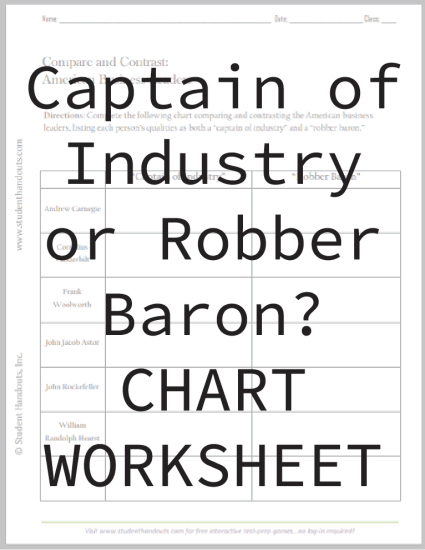Directions: complete the following chart comparing and contrasting the American business leaders, listing each person’s qualities as both a "captain of industry" and a "robber baron."
Click here to print. Answers will vary.
Note to teachers: This chart contains a blank row so that you can easily add the name of a business leader of your choosing. Another interesting option, which allows students to compare and contrast the past with the present, is to have students use this row for research on a modern business leader, such as Jeff Bezos.
The labels "captain of industry" and "robber baron" are often used to describe prominent figures in American business during the late 19th and early 20th centuries. These individuals can be viewed as both, depending on one's perspective and the impact of their actions. Here is a brief explanation of how each of the mentioned individuals can be seen as both a "captain of industry" and a "robber baron."
Andrew Carnegie
- Captain of Industry: Carnegie was a pioneering figure in the steel industry. He built a vast steel empire that helped fuel America's industrial growth. He was known for innovations in steel production and philanthropic efforts, including funding libraries and educational institutions.
- Robber Baron: Critics argue that Carnegie's success came at the expense of workers. His aggressive business practices and involvement in labor disputes, like the Homestead Strike, tarnished his reputation.
Cornelius Vanderbilt
- Captain of Industry: Vanderbilt played a significant role in developing the American transportation system, particularly in the steamship and railroad industries. His investments helped connect the country and facilitate economic growth.
- Robber Baron: Vanderbilt was criticized for his ruthless business practices, which sometimes involved undercutting competitors and monopolistic tendencies.
Frank Woolworth
- Captain of Industry: Woolworth revolutionized the retail industry with the introduction of five-and-dime stores. His innovative approach to pricing and merchandising made consumer goods more affordable and accessible to the masses.
- Robber Baron: Woolworth's business practices, such as low wages for workers and the accumulation of immense wealth, drew criticism.
John Jacob Astor
- Captain of Industry: Astor was a prominent fur trader and real estate investor. His investments in land, including vast tracts of Manhattan, contributed to urban development and economic growth in New York City.
- Robber Baron: Astor's fortune was amassed through often brutal competition in the fur trade, and he profited from the displacement of Native American populations.
John D. Rockefeller
- Captain of Industry: Rockefeller was a key figure in the development of the American oil industry. His company, Standard Oil, played a significant role in streamlining and modernizing the industry, which ultimately led to lower oil prices for consumers.
- Robber Baron: Rockefeller's business practices, including aggressive consolidation and anti-competitive tactics, led to the creation of a near-monopoly in the oil industry. This control over the market raised concerns about fair competition.
William Randolph Hearst
- Captain of Industry: Hearst was a media magnate who played a crucial role in the growth of American journalism. He expanded newspaper circulation and influenced public opinion through his publications, contributing to the development of mass media.
- Robber Baron: Critics argue that Hearst's sensationalist and sometimes unethical journalistic practices, such as "yellow journalism," were designed to sell papers at the expense of accuracy and integrity.
The dual nature of these individuals, as both captains of industry and robber barons, reflects the complexities of their contributions to American business and society. Their legacies are often subject to debate and interpretation based on different viewpoints and historical contexts.
|













